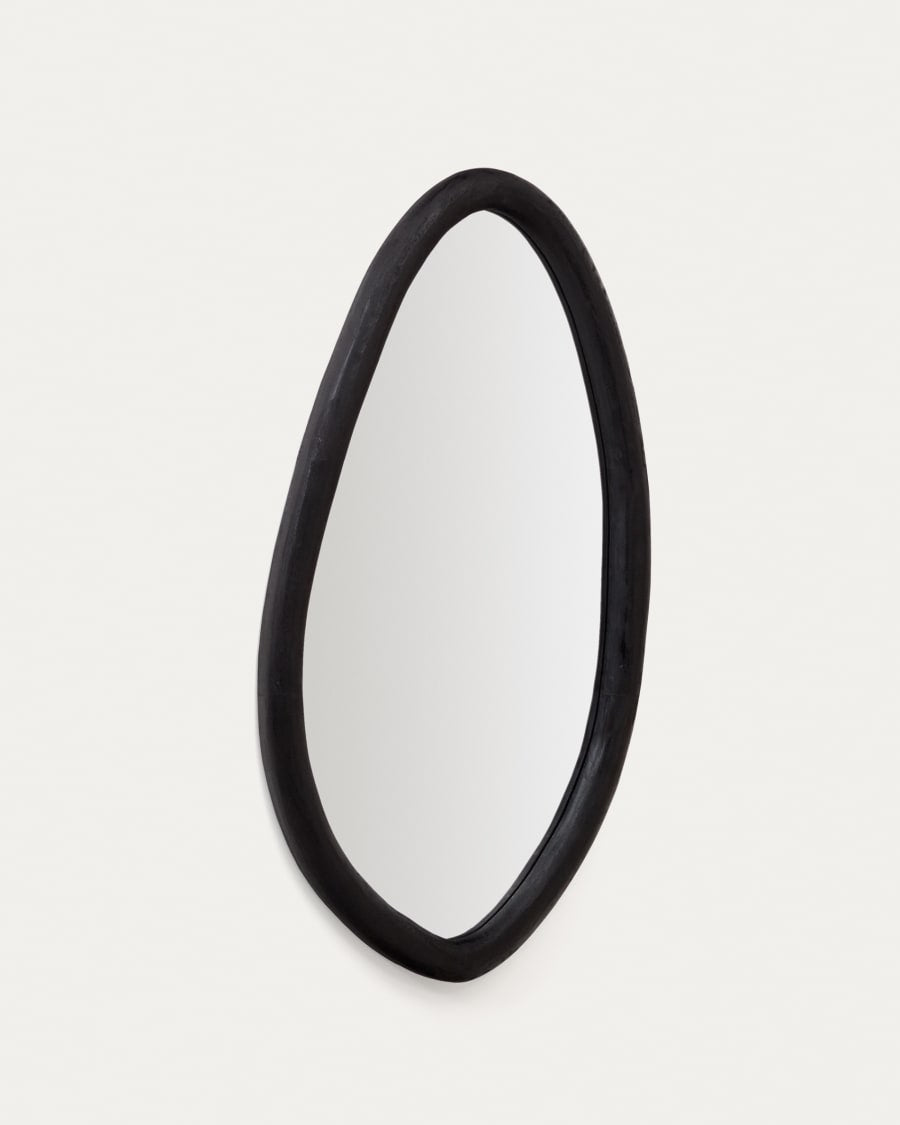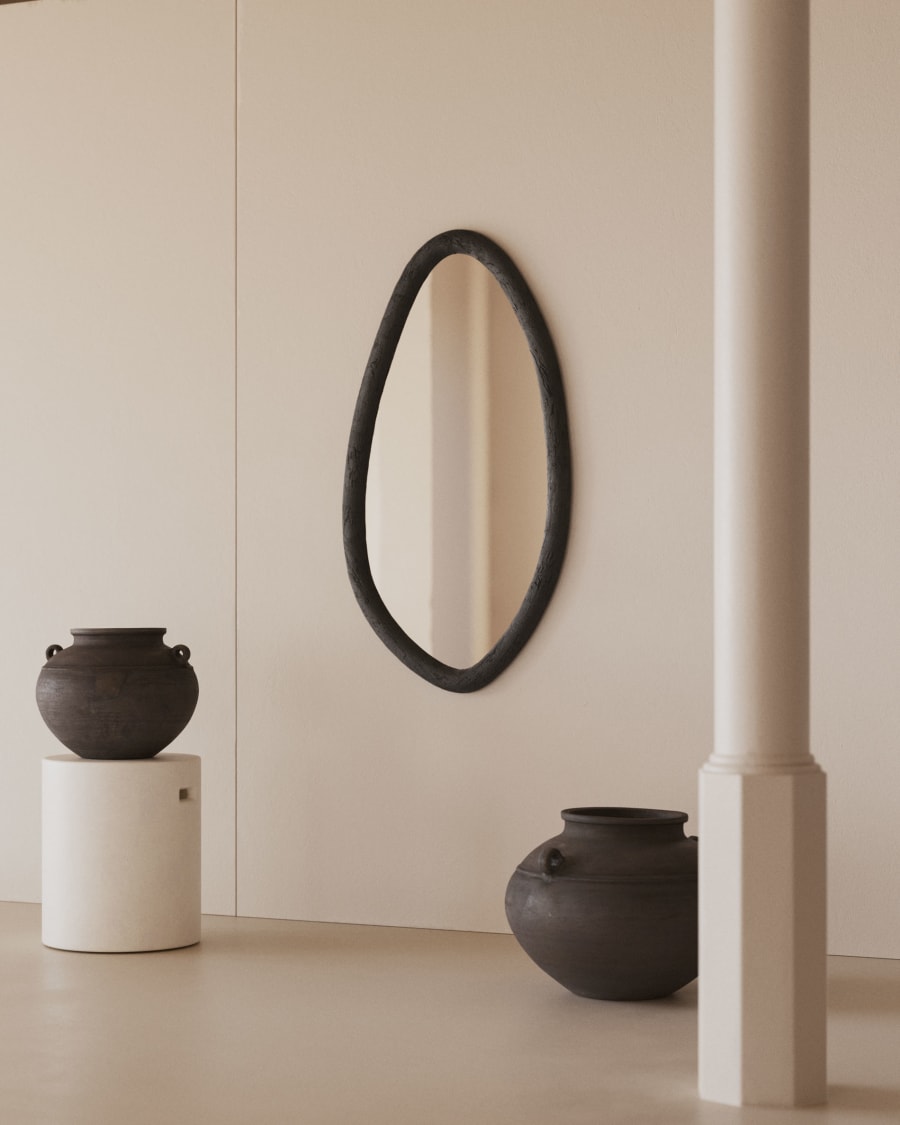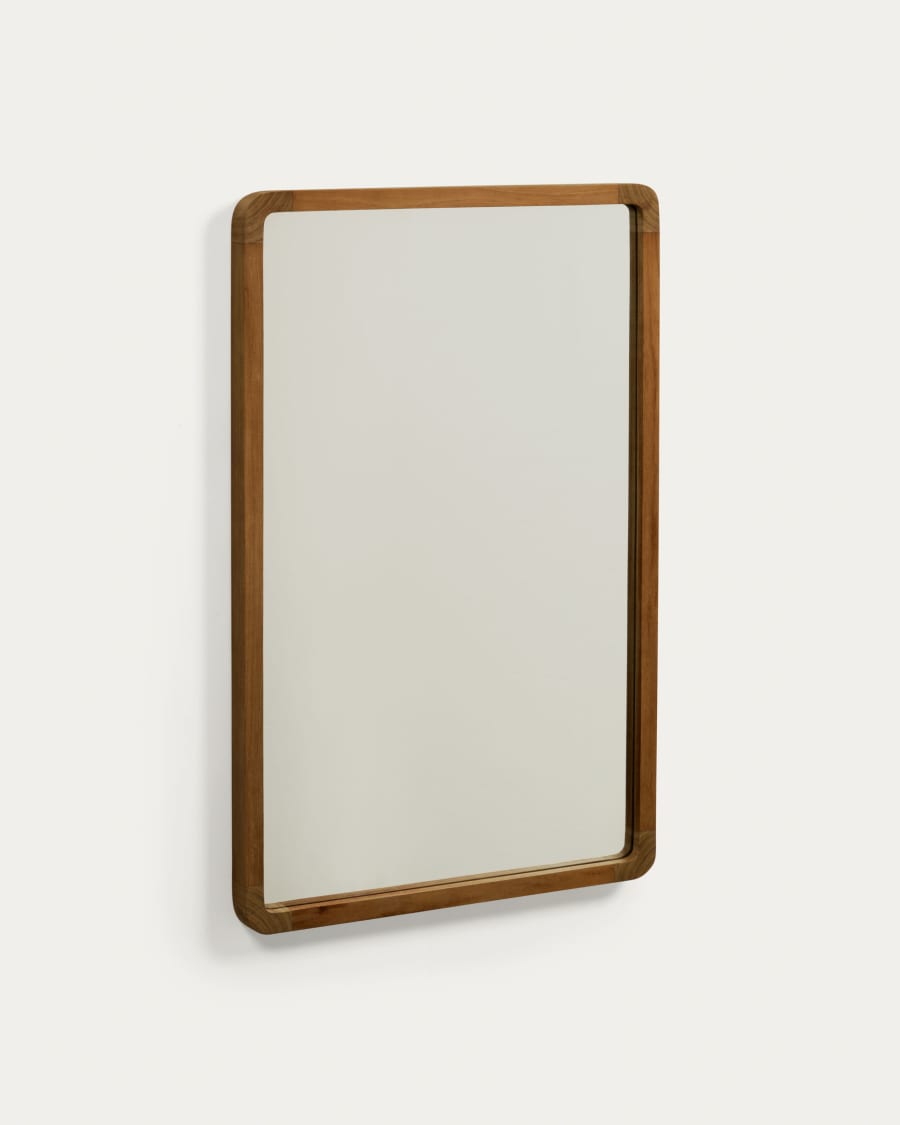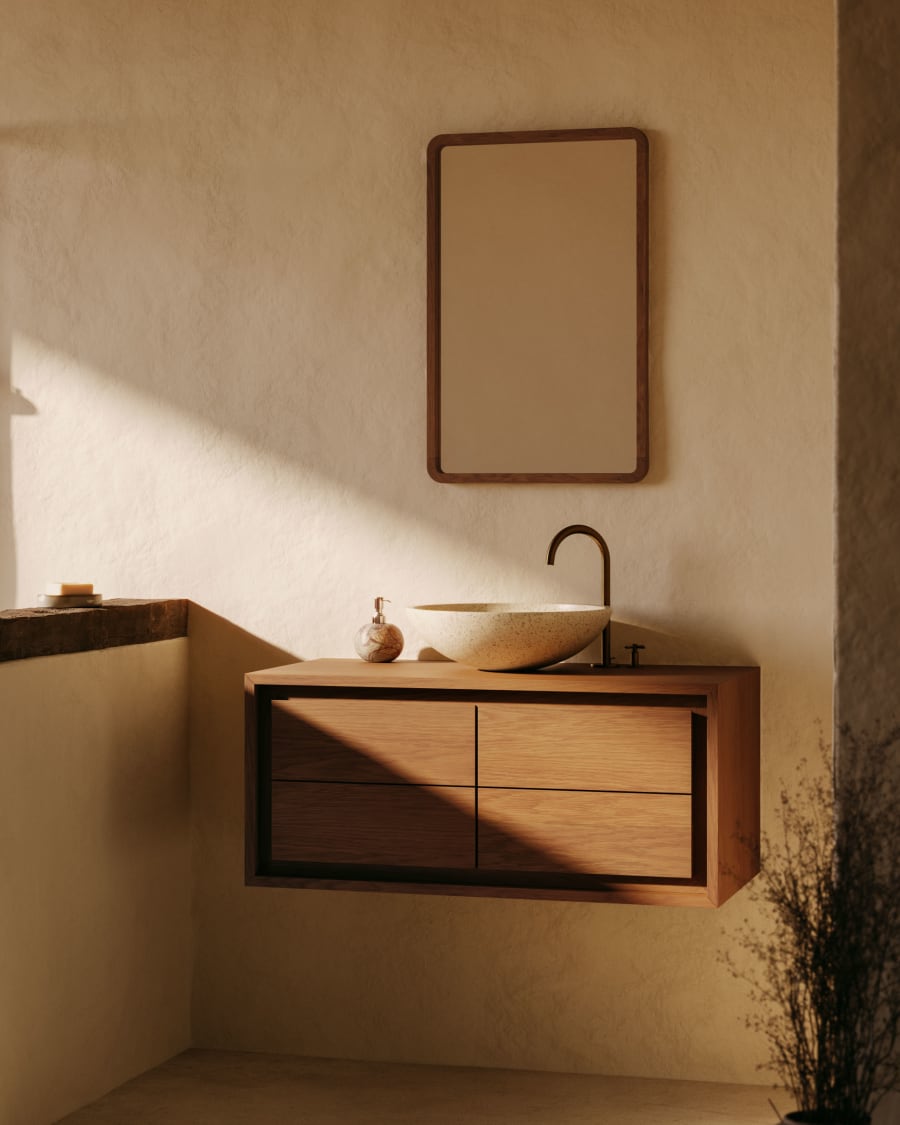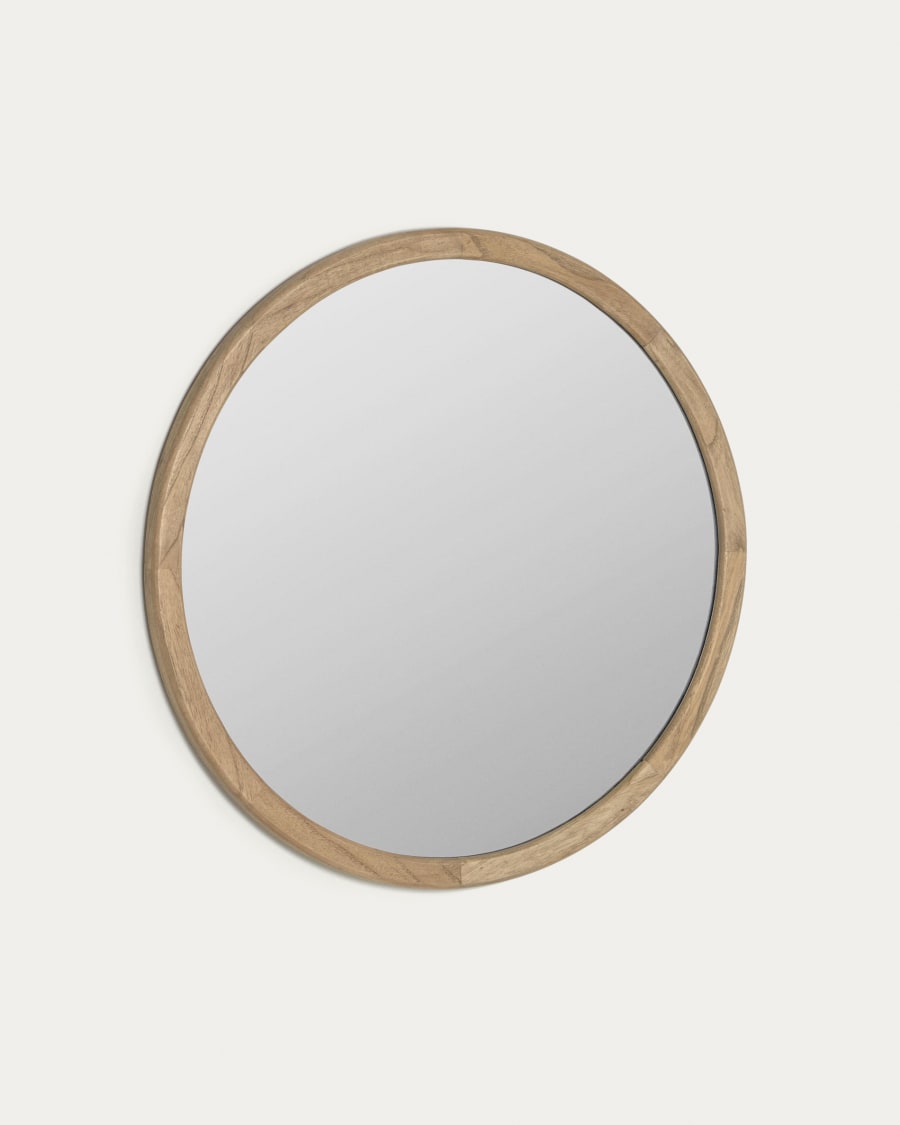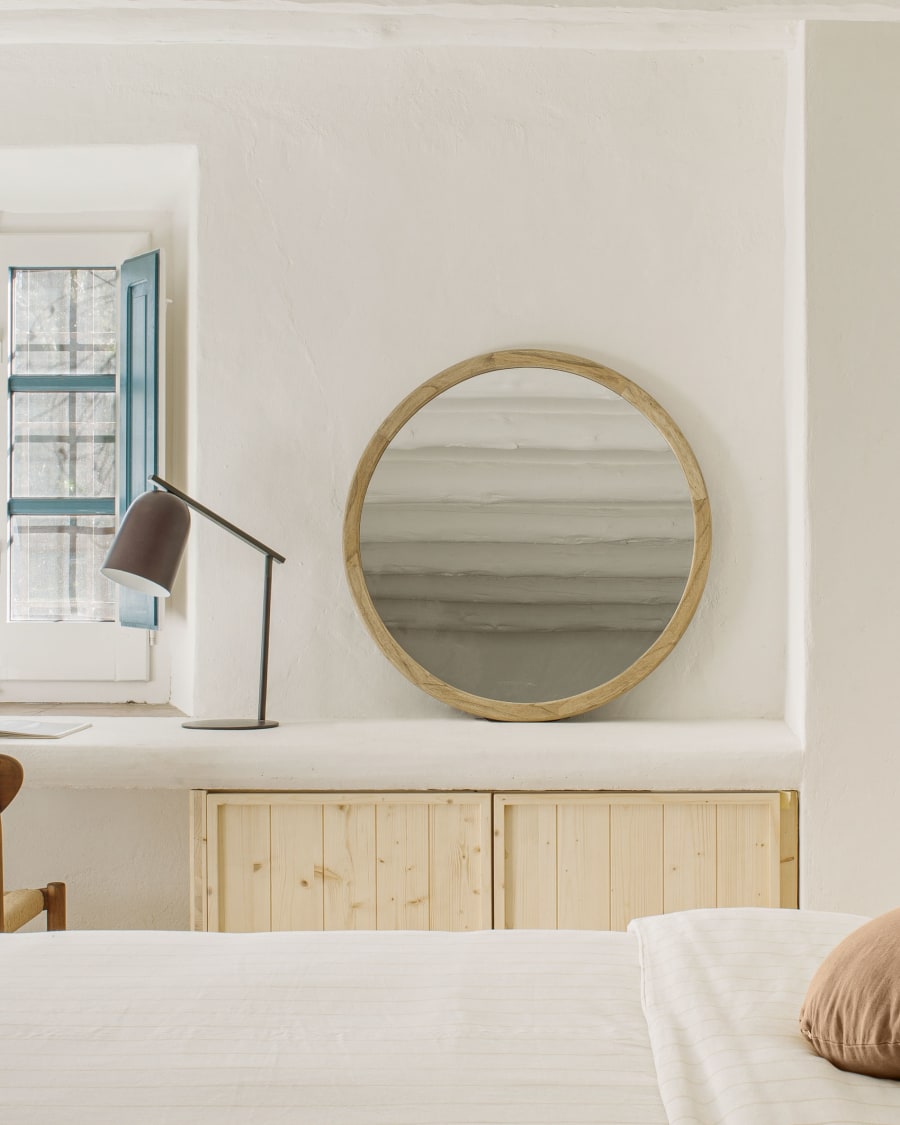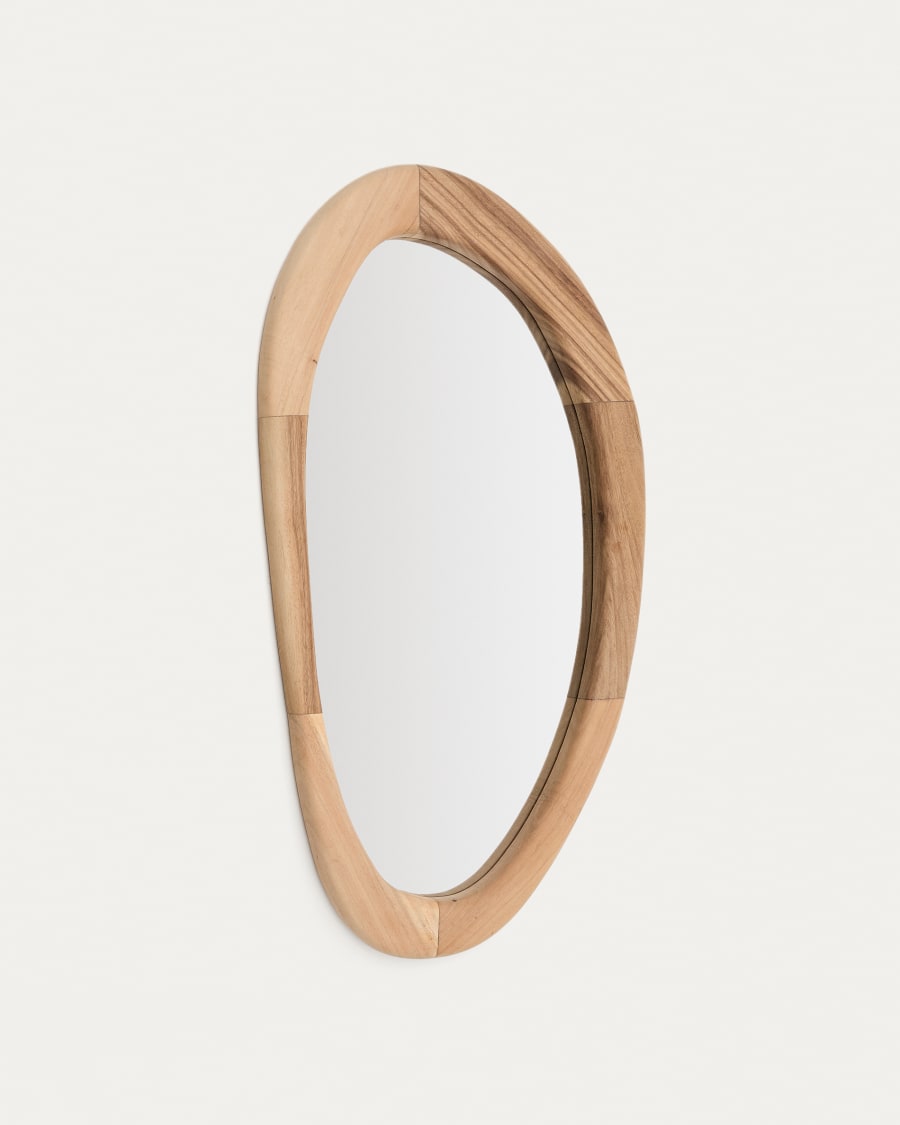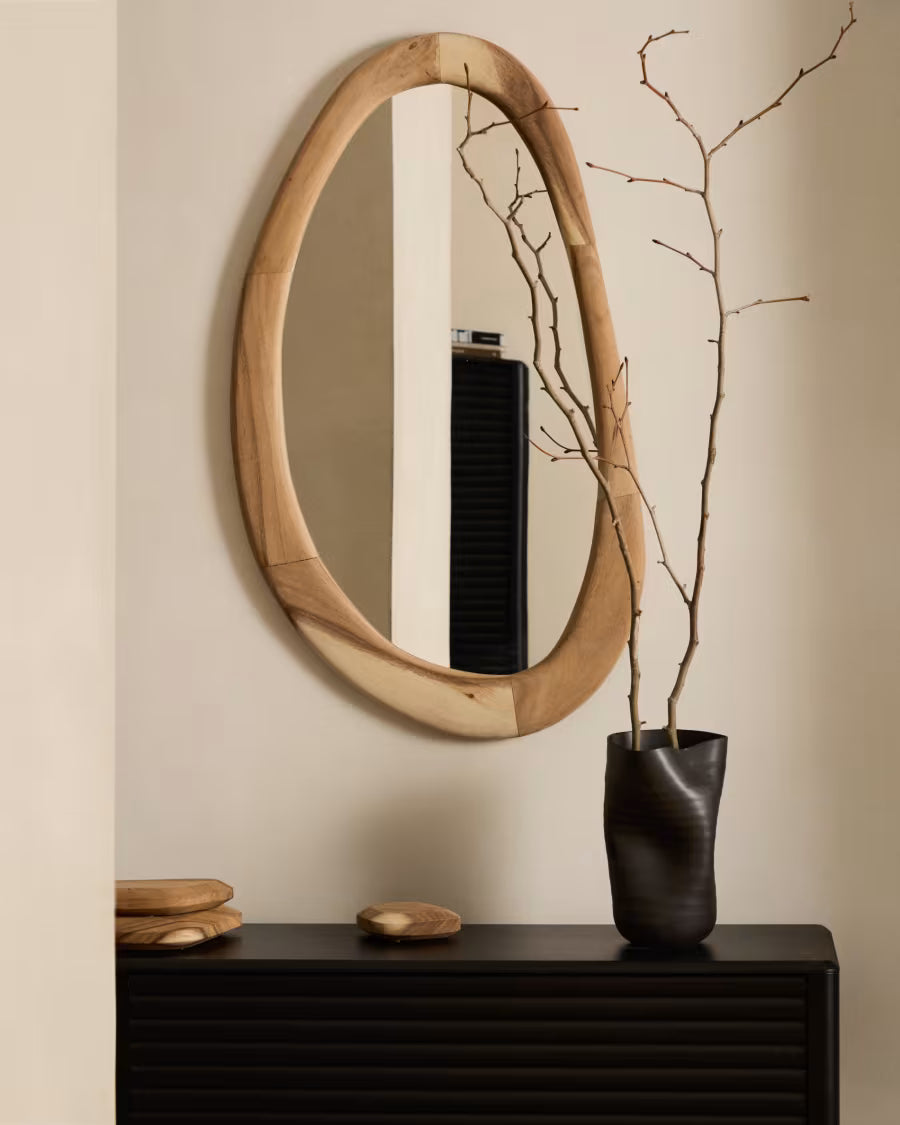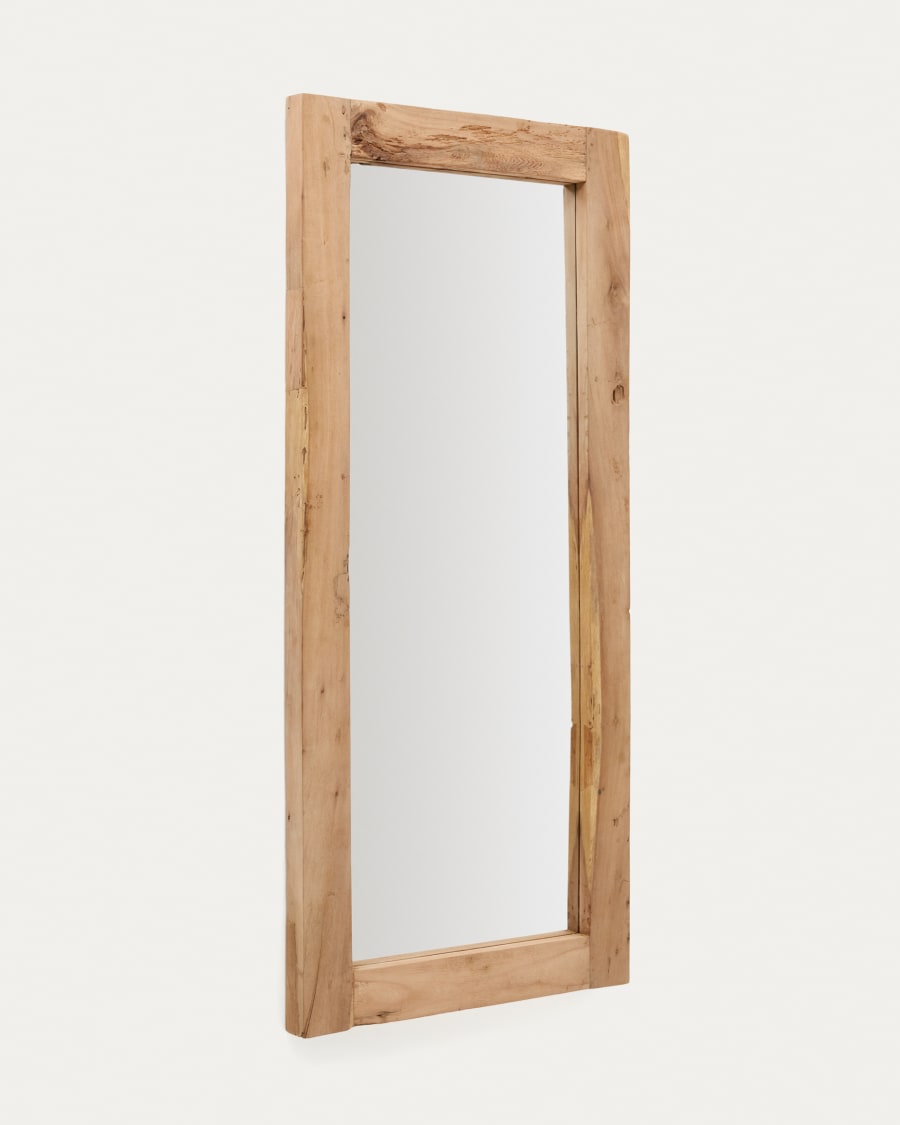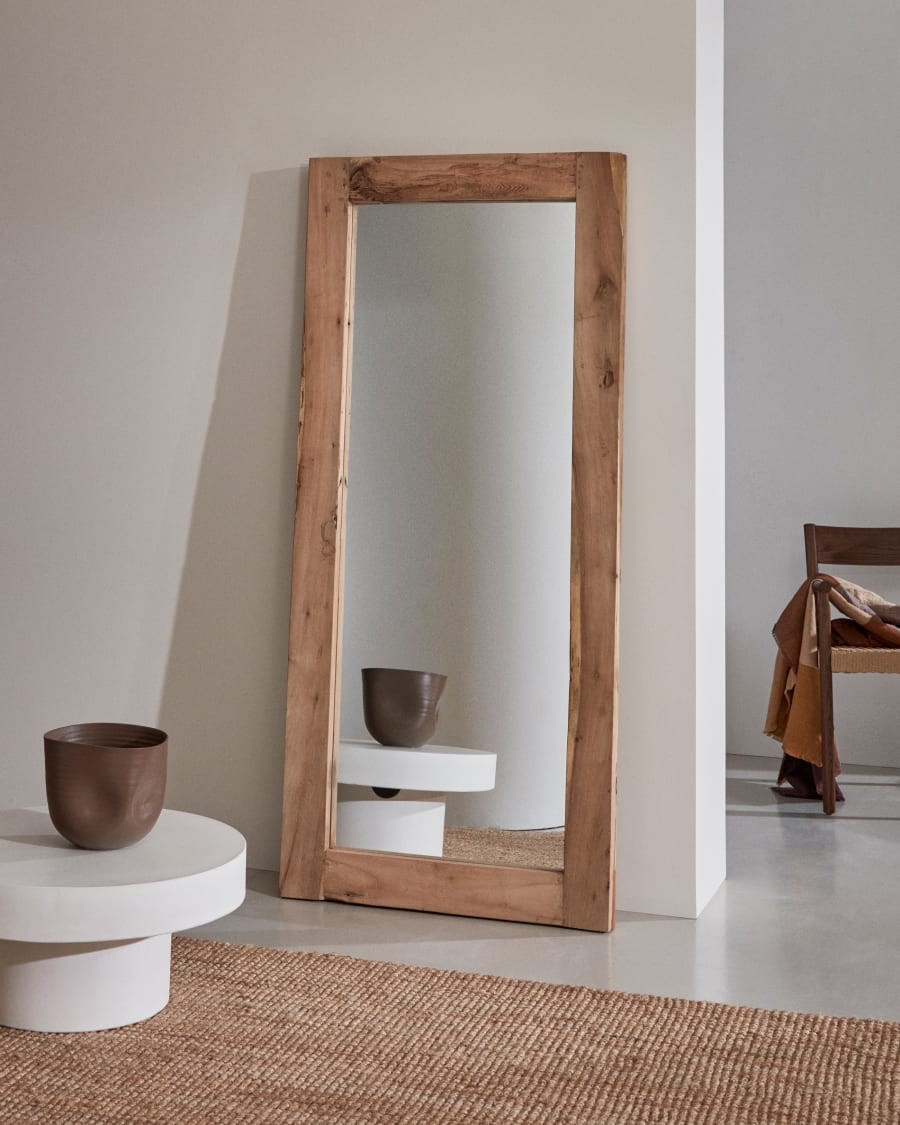- Home
- Japandi Mirrors
Japandi Mirrors
Japandi Mirrors: Minimalist & Natural Design Collection
Japandi mirrors represent more than just functional decor - they embody a design philosophy that harmonizes two powerful aesthetics. This fusion of Japanese wabi-sabi minimalism and Scandinavian hygge comfort creates interiors that feel simultaneously calming and comforting. By blending clean lines with natural materials like wood and stone accents, these mirrors become focal points that balance minimalism with warmth.
Their unique power lies in their ability to reflect both light and design principles. A single Japandi mirror can transform a space by amplifying natural illumination while maintaining visual serenity. This dual function makes them essential elements for creating serene interiors where simplicity meets sophistication.
Design Elements That Define Japandi Mirrors
Material Matters
At the heart of Japandi design sits a reverence for natural materials. Mirrors in this style showcase wood in its most elegant forms - think light oak, dark mindi, or sustainably sourced rattan. These elements bring organic warmth that prevents minimalism from feeling cold. The materials themselves tell stories through their natural grain patterns and textures, embracing imperfections that align perfectly with wabi-sabi principles.
Color Harmony
Neutral tones serve as the connective tissue between Japanese restraint and Nordic warmth. Frame finishes often feature muted earth tones that create visual continuity between spaces. Black steel contrasts beautifully with honeyed wood tones, while natural MDF maintains that essential connection to the earth. This color palette doesn't just look good - it creates environments where the mind can truly relax.
Form Functionality
Form follows function in Japandi design, but never at the expense of beauty. You'll find mirrors with clean rectangular shapes softened by rounded edges, organic curves that echo nature's patterns, and minimalist circles that create subtle visual anchors. These forms maintain simplicity while adding architectural interest, proving that functionality and elegance can coexist perfectly.
Styling Strategies For Modern Interiors
Strategic Placement
Positioning a Japandi mirror opposite a window isn't just good design - it's strategic alchemy. Natural light dances across the reflective surface, creating an illusion of expanded space while maintaining that essential sense of calm. Entryways benefit from this placement particularly well, transforming first impressions into serene welcomes.
Textural Balance
Pair your mirror with contrasting textures to create visual interest without chaos. A stone accent wall behind a wooden-framed mirror creates a perfect yin-yang dynamic. Leather chairs beside a linen sofa? That's Japandi magic in action. Even within minimalism, texture provides depth that satisfies the soul without cluttering the senses.
Lighting Integration
Modern Japandi mirrors don't shy away from technology when it enhances atmosphere. LED features with adjustable temperatures maintain that balance between tradition and innovation. Whether you need warm light for hygge moments or cooler tones for focused tasks, these mirrors adapt without compromising aesthetic integrity.
Creating Harmony In Your Space
Start with architectural elements - clean lines in furniture and cabinetry provide the structural backbone of Japandi style. Let your mirror's natural materials guide the rest of your decor choices: if you choose a bamboo-framed mirror, bring in complementary wooden accents elsewhere. Remember that true harmony comes from intentional composition, not random assortment.
Balance is key: match your mirror's minimalist frame with softer textiles in the room. A sleek black steel mirror might pair beautifully with chunky knit throws. Don't forget vertical space - large format mirrors create dramatic impact while maintaining visual clarity. The goal? Spaces that feel simultaneously ordered and inviting, functional yet peaceful.
What are Japandi mirrors?
Japandi mirrors blend Japanese wabi-sabi minimalism with Scandinavian hygge comfort. This hybrid style merges Nordic practicality with Japanese serenity, creating functional art that transforms modern interiors into calm, authentic sanctuaries where simplicity feels purposeful, not sparse. Their design philosophy answers the modern need for spaces that balance efficiency with emotional warmth.
Defined by clean lines and organic textures, these mirrors prioritize craftsmanship over ornamentation. Frames in solid oak, bleached walnut, or woven rattan highlight natural grain and tactile qualities. A bamboo-framed floor mirror might feature seagrass-wrapped edges echoing nature, while minimalist designs focus on negative space to let light and material texture drive visual interest. Unlike maximalist styles, they avoid overwhelming the senses, favoring intentionality.
- Natural materials: Wood frames develop patina; seagrass edges add texture while rattan accents introduce subtle movement. Over time, these materials age gracefully, enhancing the wabi-sabi embrace of imperfection.
- Neutral tones: Matte black contrasts pale walls; whitewashed oak suits minimalist bathrooms, and linen cords add quiet texture to entryways. These hues create calming backdrops that adapt to changing light throughout the day.
- Functionality: Arched hallway mirrors enhance light and spatial perception, while streamlined full-length designs suit compact studios. In dining rooms, rectangular mirrors with rope trims reflect candlelight to amplify hygge’s cozy atmosphere.
These mirrors intentionally slow the eye. A bedroom mirror might showcase hand-carved wood with visible knots—imperfections celebrated by wabi-sabi. The Bali & Pari Geralyn model, wrapped in seagrass with a mango wood core, exemplifies evolving organic textures that adapt to their environment, embodying the style’s dynamic interaction with nature.
Their spatial magic transforms rooms. Placed opposite windows, they amplify natural light to create openness. In bathrooms, minimalist rectangular mirrors with raw wood frames add warmth without overwhelming neutral palettes. By combining Nordic practicality with Japanese mindfulness, Japandi mirrors balance form, function, and tranquility, crafting serene spaces where every detail feels intentional yet effortless.
How To Choose A Japandi Mirror
Consider The Materials And Frame
The frame defines a Japandi mirror’s character. Opt for natural materials that blend Japanese restraint and Nordic warmth. Light oak frames evoke Scandinavian simplicity, while dark walnut adds Japanese sophistication. Matte finishes enhance raw textures, aligning with wabi-sabi’s appreciation for imperfection. For a tactile contrast, combine smooth wood with hand-woven rattan borders—Scandinavian practicality meets Japanese craftsmanship.
Explore bamboo or rattan for textured accents that echo organic shapes. Pair smooth wood with unpolished stone like travertine for tactile contrast. These combinations anchor spaces in serene, grounded energy while avoiding overly glossy or synthetic finishes. A rattan-framed mirror above a desk creates a calm workspace, merging Japandi’s functional beauty.
Select The Right Shape And Form
Rounded mirrors soften angular furniture, a core Japandi strategy. Their curves reflect Scandinavian hygge’s coziness while aligning with Japanese fluidity. Pair circular mirrors above fireplaces for visual harmony. Arched mirrors extend vertical lines, making ceilings feel taller. They channel Scandinavian symmetry while nodding to Japanese torii gates. For wabi-sabi authenticity, choose asymmetrical forms—irregular ovals or cloud-shaped frames—to celebrate nature’s randomness, a cornerstone of Japanese aesthetics.
Asymmetrical mirrors work well, where their organic shapes balance structured sofas. A cloud-shaped mirror above a minimalist bedframe introduces subtle dynamism without disrupting calm. Arched mirrors suit entryways, where their grandeur feels welcoming yet understated.
Choose The Perfect Size For Your Space
- Large / Full-length mirrors: Ideal for making small rooms feel larger and brighter. Perfect for bedrooms and entryways. Pair with a bench to create a hygge-inspired seating area. Position opposite windows to maximize natural light reflection.
- Medium-sized mirrors: Excellent as functional focal points above consoles, dressers, or sinks. Rectangular mirrors with thin wooden frames balance structure and warmth. A 24-inch round mirror above a bathroom sink merges utility with softness.
- Small or grouped mirrors: Use as decorative accents to add texture and reflect light. Mix round and irregular shapes for cohesive displays. Cluster three asymmetrical mirrors in graduated sizes for a curated yet minimalist gallery wall.
Cluster tiny mirrors above a coffee table for a gallery wall effect. Keep frames unified—try black-rimmed bamboo or stained wood—for cohesion. A medium-sized mirror above a sink merges practicality with Nordic hygge. Full-length mirrors placed opposite windows amplify daylight, a shared Nordic-Japanese strategy to combat seasonal darkness. For dining areas, a medium round mirror above the table reflects candlelight, blending hygge intimacy with Japanese ambient design.
Styling Japandi Mirrors In Your Home
In The Entryway Or Hallway
A Japandi entryway merges Scandinavian practicality with Japanese simplicity. A round mirror above a light oak bench adds elegance and reflects light to expand narrow spaces. Use full-length mirrors leaning against walls for functionality and spatial illusion. Frames in bamboo or reclaimed wood emphasize warmth with organic textures.
Pair with neutral walls and minimalist storage. A dried branch in a terracotta vase near the mirror adds organic contrast. Avoid overcrowding to preserve calm. Hang the mirror slightly off-center against textured linen wallcovering to blend asymmetry with Nordic warmth. A mid-century console table beneath the mirror—its clean lines echoing Japandi’s purposeful design—adds subtle architectural interest without disrupting minimalism.
In The Living Room
Anchor the space with a dark wood-framed wall mirror above a neutral sofa. Asymmetrical shapes honor wabi-sabi’s appreciation for imperfection. Position it to reflect natural or warm artificial light, enhancing hygge-inspired coziness. Place the mirror opposite a large window to amplify daylight or near a floor lamp for soft evening glow.
Balance with neutral textiles and low-profile furniture. A curved mirror over a stone-accented console table merges Scandinavian minimalism and Japanese fluidity. Layer a handwoven wool rug under a sleek black-framed coffee table for textural contrast without visual overload. Flank the mirror with mismatched floor cushions in undyed linen to celebrate wabi-sabi’s organic shapes while grounding the space in Nordic structure.
In The Bedroom
Angle a light oak standing mirror in a corner to create depth. Pair with linen curtains and a low wooden bed frame to ground the space in serenity. Avoid placing mirrors directly facing the bed for undisturbed rest. Opt for a frameless design to emphasize simplicity or a thin black metal border for subtle definition.
For compact rooms, an oval mirror above a minimalist dresser reflects light subtly. Use muted beige or gray bedding to complement neutral frames. Prioritize decluttered surfaces for Zen tranquility. Add a woven rattan pendant light for gentle illumination. Layer a chunky knit throw across a wooden bench at the bed’s foot to contrast smooth oak with textured wool—a tactile nod to Japandi’s duality.
In The Bathroom
Create a spa-like atmosphere with bamboo-framed mirrors. A frameless round mirror above the sink maintains modern simplicity. Pair with stone soap dishes and organic cotton towels for tactile contrast. Choose moisture-resistant light oak or ash finishes to withstand humidity while retaining warmth.
A black metal frame adds definition while preserving minimalism. Let the mirror anchor a palette of white, gray, or soft sage. Install recessed lighting above to eliminate shadows while keeping the aesthetic sleek. Enhance the organic feel with a carved teak tray holding bamboo toothbrushes and a ceramic soap dispenser—small details reinforcing Japandi’s natural material ethos through consistency.
Key features of japandi mirrors at a glance
Japandi mirrors embody a harmonious blend of Japanese wabi-sabi minimalism and Scandinavian hygge comfort. This curated table highlights essential design elements that define these mirrors, offering a quick reference for creating serene interior spaces through balanced minimalism.
| Feature | Description |
|---|---|
| Core Philosophy | A blend of Scandinavian Hygge (cozy, functional comfort) and Japanese wabi-sabi (imperfect, transient beauty). |
| Frame Materials | Primarily natural materials like light woods (oak, ash), dark woods (walnut), bamboo, and rattan. Minimalist metal frames in black or brass are also used. |
| Common Shapes | Round, oval, arch, and organic/asymmetrical forms that evoke nature and softness. |
| Color Palette | Neutral and earthy tones. Includes white, beige, cream, grey, black, and the natural colors of the wood. |
| Design Focus | Clean lines, simplicity, and functionality. The design is intentional, uncluttered, and serves a purpose beyond decoration. |
Together, these characteristics create mirrors that transcend mere functionality, becoming intentional design statements. They reflect both the Nordic emphasis on practical beauty and the Japanese appreciation for organic imperfection, transforming any space into a tranquil, modern sanctuary through balanced minimalism.
Care And Maintenance For Your Japandi Mirror
Preserving the serene elegance of a Japandi mirror requires gentle yet consistent care. These pieces blend Japanese wabi-sabi minimalism with Scandinavian hygge comfort, often featuring natural materials like wood, bamboo, or rattan. Proper maintenance ensures their textures and neutral tones maintain their calming presence in modern spaces.
For wooden, bamboo, or rattan frames, start with regular dusting using a soft, dry cloth to prevent buildup. For deeper cleaning, lightly dampen the cloth and wipe surfaces, then dry immediately with a second dry cloth. This avoids moisture seeping into joints or grain, which could warp or discolor the material over time.
- Avoid harsh chemicals: Never use abrasive cleaners on the frame, as they can damage the finish and the natural material.
- Protect from humidity: In bathrooms, ensure good ventilation to prevent moisture from warping or damaging a wooden frame. Consider frames specifically treated for damp environments.
- Limit direct sunlight: Prolonged exposure to direct sunlight can cause the color of natural wood frames to fade over time. Position the mirror accordingly.
- Mirror glass cleaning: Clean the glass with a standard glass cleaner, but spray it onto the cloth rather than directly onto the mirror to prevent the liquid from seeping behind the glass and damaging the frame or mirror backing.
Simple, regular upkeep ensures your Japandi mirror remains a harmonious focal point. By protecting its natural materials from environmental stressors, you sustain the balance of Japanese restraint and Nordic warmth that defines its tranquil aesthetic.
FAQ
What defines a Japandi mirror’s design philosophy?
Japandi mirrors embody the fusion of Scandinavian simplicity and Japanese serenity, blending functional minimalism with organic warmth. Rooted in Hygge (Scandinavian coziness) and wabi-sabi (Japanese appreciation for imperfection), these mirrors prioritize clean lines, uncluttered forms, and natural materials like light oak or dark walnut. Their design isn’t just decorative—it’s intentional, creating spaces that feel both grounded and airy, practical yet profoundly calming.
How do Japandi mirrors enhance interior spaces?
These mirrors act as subtle statement pieces, amplifying light and visual space while anchoring a room in tranquility. A round or arched mirror softens angular architecture, while asymmetrical shapes echo nature’s irregular beauty. In compact areas, large mirrors reflect light to create openness; smaller ones serve as sculptural accents. Their neutral palettes—beige, gray, or raw wood tones—complement minimalist schemes, making them versatile for entryways, bathrooms, or living areas.
What materials are typically used in Japandi mirror frames?
Natural textures define Japandi frames: sustainably sourced wood (blonde oak for Scandi brightness, walnut for Japanese depth), bamboo, or rattan for organic warmth. Some designs incorporate matte black metal or stone accents for contrast, but the focus remains on materials that age gracefully. Each choice honors the style’s ethos—craftsmanship that celebrates imperfection and sustainability, ensuring the mirror feels alive, not mass-produced.
Where should I place a Japandi mirror for maximum impact?
Strategic placement elevates both aesthetics and function. In hallways, a full-length arched mirror adds grandeur to narrow spaces. Above a console or bedhead, a round or oval mirror reflects ambient light and ties together neutral schemes. For bathrooms, opt for a bamboo-framed piece near a window to evoke spa-like serenity. Avoid direct sunlight to preserve wood finishes, and pair with linen textiles or potted plants to reinforce the nature-connected vibe.
How do I care for a Japandi mirror’s natural frame?
Maintenance is simple but mindful. Dust frames regularly with a dry microfiber cloth to protect finishes. For deeper cleaning, use a slightly damp cloth (never soaking wet) and dry immediately—moisture is the enemy of untreated wood. Avoid harsh chemicals; instead, use a mild soap like diluted Marseille soap for stains. In humid areas like bathrooms, ensure proper ventilation to prevent warping. With these steps, your mirror will age beautifully, deepening its character over time.
